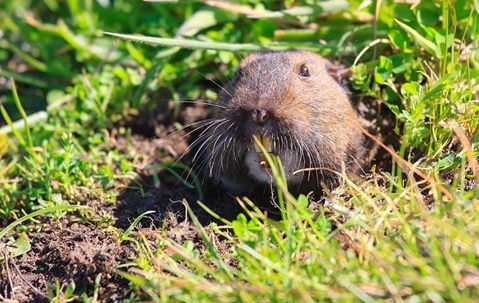If gophers or moles have come into your yard, you're likely to know it. These lawn pests can cause patches of dead grass, create raised tunnels, and large mounds of dirt, all of which can make your lawn an unsightly mess. Today, we're going to talk about how you can tell which of these two pests you have, what is important to know about them, and what other lawn pests can make you think you have a gopher or a mole.
Gopher Or Mole?
It is easy to tell these two creatures apart visually. Gophers are cute. Moles are not. Not even a little bit. Moles are also much smaller than a gopher. But you're not likely to spot either one of these critters running around in your yard. If you do see one, you're most likely to see a gopher, not a mole. This is because moles can find all the food they need under the ground. Gophers have some food preferences that are found above ground. But they don't stay above ground for long, not if they can help it. A common tactic for a gopher is to create a feed hole near some plants, come out, grab a nearby plant and drag the entire plant back down into their burrow and feed on it there. Most of the time, you're going to have to look for clues to figure out which of these pests you're dealing with in your yard.
The Anatomy Of A Dirt Mound
Both of these animals create mounds of dirt, but there are three distinct differences between them. Understanding these differences can help you get to the bottom of your pest problem. First of all, gophers create mounds of fine dirt. If you see clumps of dirt in a mound, you're dealing with a mole, not a gopher. Second, if there are several mounds and they are close together, those are probably gopher holes. The distance between mole mounds is sometimes six feet or more. Gopher holes may only be a foot apart. Third, if you scrape a mound's dirt away and can't find the hole to the tunnel, you're dealing with a mole. Gophers have much larger and sturdier holes and tunnels.
Interesting Facts About Gophers And Moles
Moles sustain themselves on a protein diet that is largely earthworms and grubs. But they'll also eat a wide range of insects that crawl in the ground. Gophers are omnivores who prefer nuts, plant bulbs, berries, grass, leaves, and bugs. If you see damage to the plants on your property, you have a gopher problem.
When a mole moves in, it will sometimes move on. Moles can travel quite a distance under the ground. If you have a mole mound next to your driveway and you don't see any other mounds, you may be able to remove that dirt, pack the ground down, and be done with your infestation. But, when a mole finds good feeding in your yard, it can create a lot of tunnels in a single night. Some studies estimate that they can create as much as 50 to 60 yards of tunneling in one night. That could add up to a lot of lawn damage.
Lawn Damage Caused By Gophers And Moles
Some lawn pests and even lawn diseases can make you think you have a gopher or a mole problem. Voles can come into your yard and create paths through your grass. Developing beetle larvae (grubs) can create patches of dead grass in your yard. Norway rats can create burrows in the ground, especially under piles of objects. Cicada killer wasps can create burrows. And several diseases attack turfgrass, such as brown patch and dollar spot.
Overson Pest Can Help With Your Lawn Pest Problems
If you live in Phoenix or the surrounding area, the team here at Overson Pest Control can help you figure out what pest you're dealing with. And, if it is a gopher or mole problem, we have experienced gopher and mole trappers trained and equipped to hunt those destructive pests down and remove them. Reach out to us today to learn more about how we can protect your lawn and your garden from destructive pests!

